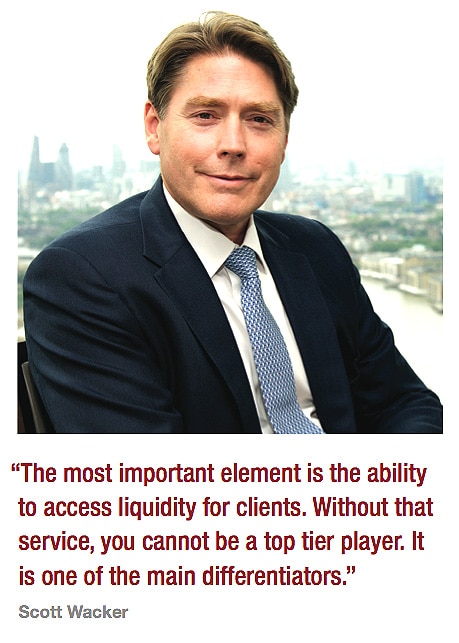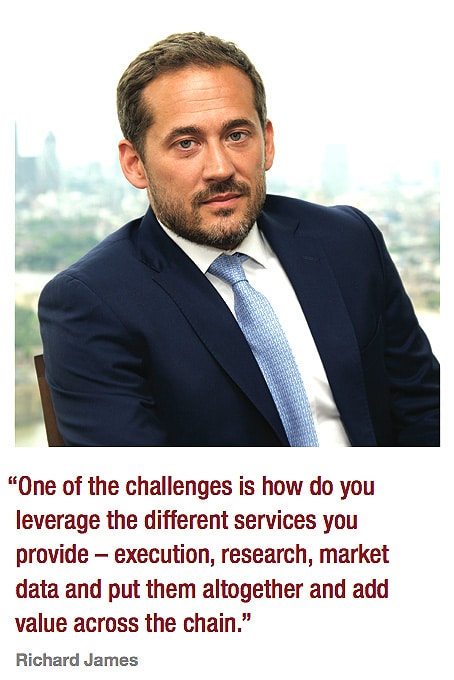TAKING THE LONG VIEW.
Scott Wacker, global head of e-commerce sales and marketing and Richard James, head of FX execution services at J.P. Morgan discuss how they are staying in front of the new regulatory regime.
What impact is regulation having on the industry?
Scott Wacker: The regulatory environment keeps changing but we have a clearer line of sight in the US because Dodd Frank has already been implemented. This is not the case in Europe where we do not expect to get clarity over MiFID II until 2017. The deadlines keep moving and that puts banks in a tough position. One of the big questions in Europe is whether to move ahead with any required investments or wait to see how things unfold. As for Asia Pacific, we will see whether it follows the US and EMEA’s lead and what kind of products are needed as it is a much more heterogeneous region than the other two.
Is it possible to leverage an equity framework on other asset classes?
Scott Wacker: It is difficult to apply an equity-like framework on other asset classes. But there is a lot which can be adapted and transferred, because each asset class has different characteristics and conforms to different market structures. Some trade on exchanges where trading activity is publically recorded and a benchmark is easy to determine, and others trade OTC and do not have independent or reliable benchmarks. Equally, some offer predominantly agency-based execution, others, principal-based execution, but what is interesting is the comingling of the two. However, despite the differences, there are a number of execution tools and techniques which are proliferating across asset classes. For instance, the development of algorithmic order execution capabilities and pre and post trade analytics are increasingly being employed across asset classes. If we take FX as an example, there has been a perceptible rise in the development and the use of fee and spread-based algorithmic order execution, pre-trade and post-trade transaction cost analysis, and a shift to a fee-based, agency styled WMR fixing methodology which is entirely electronically risk managed. While unique to the FX market, these tools and techniques are on the radar in various other traded markets as the electronic capabilities evolve and the demand for transparency and execution measurement increases.
What changes have you made over the year and how is your group contributing to the bank’s ability to meet any changes in market structure and increased electronic trading?
Richard James: We have seen increased interest in cross-asset class trading from our clients and have made structural changes to support the evolving landscape through the creation of one (primarily) electronic group called J.P. Morgan Execution Services, where we can act on our clients’ behalf by trading as agent or principal. We have also built out J.P. Morgan Markets, our single dealer platform, which combines a range of asset classes, trading applications, research, analytics and data in one place. In our view, we have created a better client experience by ensuring that our salespeople and traders are facing the same platform that our clients are using.
When was J.P. Markets first launched?
 Scott Wacker: J.P. Morgan Markets was launched in 2013 and one of the main drivers was efficiency. It made sense, for example, to have one log-in on to one proprietary application rather than 38 client-facing applications across different asset classes. This allowed us to combine separate services such as research, analytics, data, metrics and structuring tools, onto one platform. We started with research and FX execution, then added analytics, execution, strategy, and pre and post trade analytics for commodities, rates, credit, and equities.
Scott Wacker: J.P. Morgan Markets was launched in 2013 and one of the main drivers was efficiency. It made sense, for example, to have one log-in on to one proprietary application rather than 38 client-facing applications across different asset classes. This allowed us to combine separate services such as research, analytics, data, metrics and structuring tools, onto one platform. We started with research and FX execution, then added analytics, execution, strategy, and pre and post trade analytics for commodities, rates, credit, and equities.
Client expectations have grown massively in terms of the service they expect to receive. The result has been that we continue looking at how we can add value. For example, this year we are launching two new products on our FX offering. The first is notifications, or tailor-made alerts which automatically inform clients about events that will impact their investment and trading decisions. This could be, for example, if dollar volumes exceed 3% of average daily volume. The second is an FX aggregator which is due to go live in the Autumn. This will increase pre-trade transparency and simplify the pricing of algo orders. We are also planning to enhance our precious and base metals with new functionality, as well as add energy products and capabilities to the platform in the third or fourth quarter of this year.
Have you developed products for the mobile?
 Richard James: We have made significant investments in developing our FX mobile execution services offered to our institutional clients. Our mobile app now supports execution, access to real-time research commentary, charting and access to indicative pricing for FX options and base metals. We have also integrated notifications, providing users with the ability to tailor notifications around market conditions and trade executions. The mobile experience is fully integrated with our desktop and the two are complementary to each other.
Richard James: We have made significant investments in developing our FX mobile execution services offered to our institutional clients. Our mobile app now supports execution, access to real-time research commentary, charting and access to indicative pricing for FX options and base metals. We have also integrated notifications, providing users with the ability to tailor notifications around market conditions and trade executions. The mobile experience is fully integrated with our desktop and the two are complementary to each other.
The early adopters have predominantly been hedge funds and corporates, but more recently we have seen increased interest from larger institutional clients. Our internal traders and salesforce also have the app to trade and keep up to date with market changes when they are on the move. We expect the usage of our mobile devices to continue to grow but, as with all new methods of execution, it can take time for them to be more broadly adopted.
Looking ahead, how do you see electronic trading developing?
Scott Wacker: Different markets have different value propositions. FX, for example, is big, volatile and fragmented but can be a profitable market even at the narrowest of spreads. However, despite electronic volumes exploding and the proportion of overall volume market share growing across asset classes, most of the profits are still derived from the traditional high touch business, given its complexity and the risk associated with providing solutions to bespoke client requirements.
Even with futures and equities, two asset classes which have been extremely electronic for a long time, clients still need a strong high touch offering to augment the electronic part of the business. For us, this means providing the full service suite, including algos, smart order routing as well as the research, analytics and data. The most important element is the ability to access liquidity for clients. Without that service, you cannot be a top tier player. It is one of the main differentiators.
[divider_line]©BestExecution 2015





